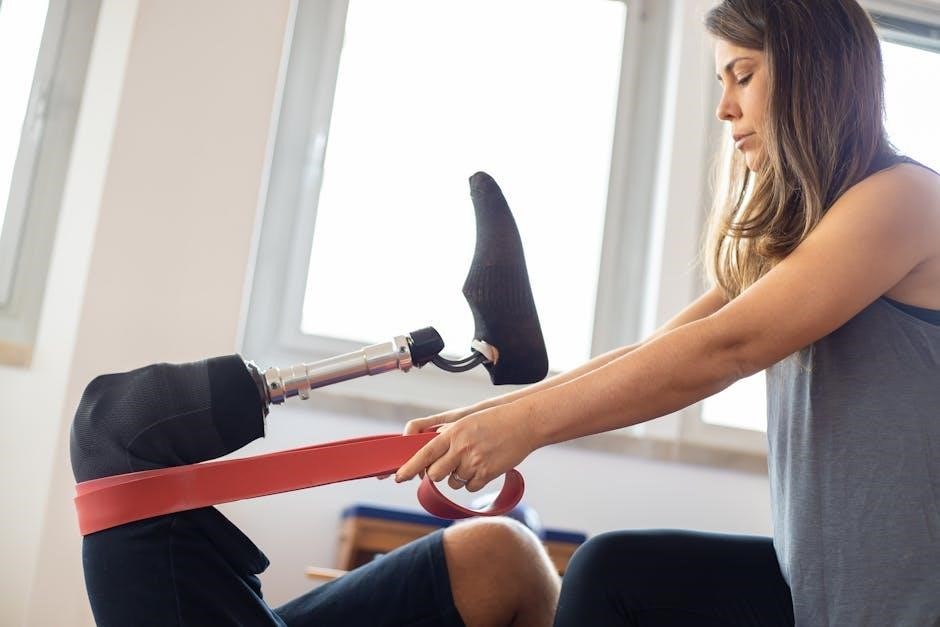Therapy band exercises offer a versatile and effective way to improve strength, flexibility, and mobility. Portable and affordable, they are ideal for rehabilitation and home workouts.
1.1 What Are Therapy Bands?
Therapy bands, also known as resistance bands, are flexible, latex-free tools used for strength training and rehabilitation. They provide varying levels of resistance to improve muscle strength, flexibility, and mobility. Portable and versatile, they are widely used in physical therapy, home workouts, and rehabilitation programs to target different muscle groups effectively.
1.2 Benefits of Using Resistance Bands in Therapy
Resistance bands enhance strength, mobility, and functionality while reducing joint pain. They are ideal for rehabilitation, home workouts, and improving range of motion. Portable and cost-effective, they offer versatile exercises targeting multiple muscle groups, making them a valuable tool for physical therapy and fitness programs.
Upper Body Therapy Band Exercises
Strengthen your upper body with exercises targeting the chest, shoulders, and back. Improve posture, mobility, and overall strength using resistance bands tailored for effective workouts.
2.1 Chest Pull Exercise
Loop the band around each palm, sit or stand with feet shoulder-width apart. Pull the band outward across your chest, squeezing your chest muscles. Hold for a few seconds, then slowly return. Aim for 10-15 reps. This exercise strengthens the chest and shoulder muscles, improving posture and overall upper body strength. Perform with controlled movements for best results.
2.2 Shoulder Shrug Exercise
Stand on the band with feet shoulder-width apart, holding the ends by your sides. Keeping knees slightly bent, shrug your shoulders upward, pulling the band toward your shoulders. Avoid using your neck. Hold for 2-3 seconds, then slowly lower. This strengthens the trapezius and rhomboid muscles. Perform 10-12 reps for improved posture and shoulder stability.
2.3 Seated Row Exercise
Sit on the floor with legs extended, loop the band around your feet, and hold the ends. Pull the band toward your chest, keeping elbows high and back straight. Focus on engaging your back muscles without rounding your shoulders. Slowly return to the starting position. Perform 10-12 reps for 2-3 sets to strengthen the latissimus dorsi, rhomboids, and trapezius muscles.
Lower Body Therapy Band Exercises
Therapy bands are excellent for strengthening leg muscles, improving flexibility, and enhancing mobility. They are versatile for rehabilitation and home workouts, targeting hips, knees, and ankles effectively.
3.1 Seated Leg Extension
Sit straight with feet flat, loop the band around one leg. Extend the leg slowly, then return. This targets quadriceps and improves knee mobility. Perform 12-15 reps for each leg. Ideal for strengthening and rehabilitation. Progress gradually by increasing resistance as strength improves. Ensure smooth, controlled movements to maximize effectiveness and prevent strain. A versatile exercise for home or clinical settings, enhancing lower body function effectively.
3.2 Standing Hip Abduction
Stand tall with feet shoulder-width apart, loop the band around your ankles. Slowly lift one leg outward, keeping it straight, then lower. Perform 12-15 reps per leg. This exercise strengthens the gluteus medius, improving hip stability and posture. Use a chair for balance if needed. Ideal for enhancing lower body strength and reducing injury risk. Focus on controlled movements for optimal results.
3.3 Ankle Plantar Flexion
Sit or stand with the resistance band looped around the ball of your foot, holding the ends in your hands. Slowly point your foot downward, stretching the band, then return to the starting position. Perform 12-15 reps to strengthen the calf muscles and Achilles tendon, improving balance and mobility. Adjust resistance levels based on fitness goals and comfort.
Core Strengthening Exercises
Therapy bands effectively target the abs and obliques, enhancing posture and stability. Use them for exercises like banded Russian twists to engage the core muscles dynamically and safely.
4.1 Banded Russian Twists
The banded Russian twist targets the obliques and improves rotational strength. Sit with knees bent, hold the band, and twist torso side-to-side, keeping arms straight. Focus on controlled movements to maximize engagement and avoid strain. Ideal for enhancing core stability and posture, this exercise is versatile for various fitness levels. Use a resistance level that challenges but doesn’t overwhelm.
4.2 Band-Resisted Plank
The band-resisted plank enhances core stability and strength by adding resistance. Loop the band around your shoulders and perform a plank, engaging your abs. The added tension challenges your core and improves posture. Hold for 30-60 seconds, focusing on maintaining a straight line from head to heels. Avoid letting hips sag for optimal results and increased muscle engagement.
Safety Tips and Precautions
Always inspect bands for damage before use. Avoid overstretching and use proper form to prevent injury. Consult a healthcare professional for personalized guidance and safety.
5.1 Choosing the Right Resistance Level
Start with lighter resistance levels and gradually increase as strength improves. Select bands based on fitness goals and current ability to avoid injury. Light resistance is ideal for rehabilitation, while heavier bands suit advanced strength training. Always consult a therapist or instructor to ensure the chosen level aligns with your specific needs and progress.
5.2 Avoiding Common Injuries
To prevent injuries during therapy band exercises, ensure proper warm-up, use correct form, and avoid overstretching. Consult a physical therapist for personalized guidance. Start with lighter resistance and progress gradually. Discontinue any exercise causing pain. Be mindful of latex allergies if using Thera-Band products. Always prioritize controlled movements and gradual progression to enhance safety and effectiveness.
Advanced Therapy Band Techniques
Dynamic stretching and eccentric strengthening enhance flexibility and muscle endurance. Incorporate these techniques into your workout plan for improved results and advanced therapy band exercises.
6.1 Dynamic Stretching with Bands
Dynamic stretching with bands combines movement and resistance to improve flexibility and range of motion. By incorporating controlled leg swings, arm circles, and torso twists, users can enhance circulation and reduce muscle stiffness. This technique is particularly effective for warm-ups and cool-downs, preparing the body for more intense exercises or aiding in recovery. Regular practice promotes better mobility and overall athletic performance;
6.2 Eccentric Strengthening Exercises
Eccentric strengthening exercises focus on the lengthening phase of muscle contraction, enhancing strength and reducing injury risk. Using therapy bands, users can perform controlled, slow movements that target specific muscle groups. This technique is particularly effective for rehabilitation and improving joint stability; Regular practice with resistance bands promotes muscle endurance and overall functional strength.

Creating a Workout Plan
Creating a workout plan with therapy bands involves tailoring exercises to your goals, tracking progress, and incorporating a mix of upper, lower, and core exercises for balanced strength.
7.1 Setting Goals and Tracking Progress
Setting clear, measurable goals is essential for a successful therapy band workout plan. Define specific objectives, such as improving strength or mobility, and track progress using printable exercise charts or journals. Regularly assess improvements in resistance levels or exercise difficulty. Celebrate milestones to stay motivated and adjust goals as needed for continued growth and adherence to your routine.
7.2 Sample Workout Routine
A sample workout routine might include 3 sets of 12-15 repetitions of exercises like chest pulls, shoulder shrugs, and seated rows for the upper body. For the lower body, incorporate seated leg extensions and standing hip abductions. Core exercises like banded Russian twists can be added for 2-3 sets of 20 twists. Use printable charts to organize and track your exercises effectively.
Therapy Band Exercises for Rehabilitation
Therapy band exercises are effective for post-surgery recovery and injury rehabilitation. They enhance strength, mobility, and flexibility, aiding in tailored recovery programs for specific injuries.
8.1 Post-Surgery Recovery Exercises
Therapy bands are highly effective for post-surgery recovery, promoting gentle strength and mobility restoration. Exercises like leg extensions and seated rows improve circulation and flexibility without overexertion. Progressing gradually under a physical therapist’s guidance ensures safe and effective recovery, minimizing complications and accelerating healing. These exercises are tailored to individual needs, making therapy bands an essential tool in post-operative rehabilitation programs.
8.2 Injury-Specific Rehabilitation Programs
Therapy bands are widely used in injury-specific rehabilitation for conditions like IT band syndrome, shoulder injuries, and knee injuries. They provide controlled resistance to strengthen muscles and improve joint stability. Programs are tailored to address pain points and restore function, making therapy bands a cornerstone in targeted injury recovery and physical therapy regimens.

PDF Resources and Guides
Downloadable PDF guides provide detailed instructions and printable charts for therapy band exercises, helping users follow structured programs for strength training and rehabilitation effectively anywhere.
9.1 Printable Exercise Charts
Printable exercise charts offer clear visual guides for therapy band exercises. They include step-by-step instructions, diagrams, and progression tracking. These charts are ideal for home use, ensuring proper form and consistency. Many PDF resources provide customizable charts tailored to specific muscle groups or fitness levels, making them versatile for both rehabilitation and general strength training. They enhance adherence to workout routines and provide a structured approach to achieving fitness goals.
9.2 Detailed Instructional Guides
Detailed instructional guides provide comprehensive step-by-step instructions for therapy band exercises. These guides often include photos, videos, and tips for proper form and progression. They cover various muscle groups and fitness levels, ensuring safe and effective workouts. Many PDF guides are designed for both clinicians and patients, offering evidence-based protocols for rehabilitation and strength training. They are essential for maximizing the benefits of therapy band exercises and minimizing injury risks.

Clinician and Patient Guidelines
Clinicians should tailor therapy band programs to patient needs, ensuring proper technique and progression. Patients must follow prescribed routines, avoid overexertion, and communicate discomfort promptly for safe outcomes.
10.1 Clinician’s Protocol for Therapy Band Exercises
Clinicians should follow a structured protocol: assess patient needs, create personalized programs, demonstrate exercises, provide feedback, and monitor progress. Adjust resistance levels as tolerance improves. Ensure clear communication and document outcomes. Educate patients on proper technique and safety to maximize effectiveness and adherence to the therapy plan. Regular follow-ups are essential for continuous improvement.
10.2 Patient Adherence and Compliance Tips
Encourage patients to set clear goals, track progress, and use instructional resources. Start with manageable routines, gradually increasing intensity. Schedule exercises consistently, incorporating reminders and rewards for motivation. Provide positive reinforcement and feedback to maintain engagement. Ensure patients understand the importance of proper technique and pacing to avoid injury and achieve optimal results.

Troubleshooting Common Issues
Address improper technique, insufficient tension, or equipment malfunctions. Adjust resistance levels, inspect bands for wear, and follow guidelines to ensure safe and effective exercise performance.
11.1 Addressing Resistance Band Malfunction
Inspect bands for cracks, frays, or excessive wear. Avoid using damaged bands to prevent breakage during exercises. Store bands away from direct sunlight and extreme temperatures to maintain elasticity. Clean bands with mild soap and water; avoid harsh chemicals. Replace bands if they show signs of deterioration or lose resistance. Ensure proper use to extend lifespan and safety.
11.2 Modifying Exercises for Different Fitness Levels
Adjust resistance levels by choosing lighter or heavier bands. For beginners, reduce tension by holding the band closer; for advanced, increase tension by stretching further. Modify repetitions and sets based on fitness goals. Shorten or extend the range of motion for individual comfort. Progress gradually to avoid strain, ensuring safe and effective workouts for all fitness levels.
Therapy bands are a versatile tool for rehabilitation and strength training. For further guidance, explore downloadable PDF guides and detailed exercise manuals. Consult professionals for personalized plans.
12.1 Summary of Key Points
Therapy bands are versatile tools for rehabilitation and strength training, offering portability and affordability. They improve strength, flexibility, and mobility across various muscle groups. Proper technique is essential to avoid injury, and selecting the right resistance level ensures effectiveness. Incorporating therapy bands into workout routines can enhance physical therapy outcomes and overall fitness. Regular use promotes long-term musculoskeletal health and functional ability.
12.2 Recommended Reading and Additional Resources
For further learning, explore the Thera-Band Exercise Guide and downloadable Resistance Band Workout Plan PDF. Visit OrthoIndy’s website for video tutorials and detailed instructions. Clinical studies on resistance band effectiveness are available through academic journals and physical therapy associations. Additional resources include the Printable Exercise Chart and guides from Worcester University’s health portal for comprehensive workout plans and safety tips.